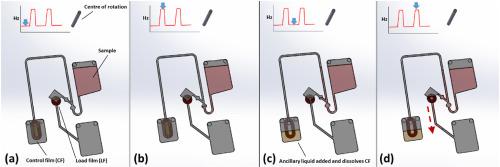Analytica Chimica Acta ( IF 5.7 ) Pub Date : 2023-03-09 , DOI: 10.1016/j.aca.2023.341070 Rohit Mishra 1 , Lourdes An Julius 2 , Jack Condon 2 , Patricija Pavelskopfa 2 , Philip L Early 3 , Matthew Dorrian 2 , Katarina Mrvova 2 , Grace Henihan 2 , Faith Mangwanya 2 , Tanya Dreo 4 , Jens Ducrée 5 , Niall P Macdonald 2 , Cor Schoen 6 , David J Kinahan 7

|
By virtue of its ruggedness, portability, rapid processing times, and ease-of-use, academic and commercial interest in centrifugal microfluidic systems has soared over the last decade. A key advantage of the LoaD platform is the ability to automate laboratory unit operations (LUOs) (mixing, metering, washing etc.) to support direct translation of ‘on-bench’ assays to ‘on-chip’. Additionally, the LoaD requires just a low-cost spindle motor rather than specialized and expensive microfluidic pumps. Furthermore, when flow control (valves) is implemented through purely rotational changes in this same spindle motor (rather than using additional support instrumentation), the LoaD offers the potential to be a truly portable, low-cost and accessible platform. Current rotationally controlled valves are typically opened by sequentially increasing the disc spin-rate to a specific opening frequency. However, due lack of manufacturing fidelity these specific opening frequencies are better described as spin frequency ‘bands’. With low-cost motors typically having a maximum spin-rate of 6000 rpm (100 Hz), using this ‘analogue’ approach places a limitation on the number of valves, which can be serially actuated thus limiting the number of LUOs that can be automated. In this work, a novel flow control scheme is presented where the sequence of valve actuation is determined by architecture of the disc while its timing is governed by freely programmable ‘digital’ pulses in its spin profile. This paradigm shift to ‘digital’ flow control enables automation of multi-step assays with high reliability, with full temporal control, and with the number of LUOs theoretically only limited by available space on the disc. We first describe the operational principle of these valves followed by a demonstration of the capability of these valves to automate complex assays by screening tomato leaf samples against plant pathogens. Reagents and lysed sample are loaded on-disc and then, in a fully autonomous fashion using only spindle-motor control, the complete assay is automated. Amplification and fluorescent acquisition take place on a custom spin-stand enabling the generation of real-time LAMP amplification curves using custom software. To prevent environmental contamination, the entire discs are sealed from atmosphere following loading with internal venting channels permitting easy movement of liquids about the disc. The disc was successfully used to detect the presence of thermally inactivated Clavibacter michiganensis. Michiganensis (CMM) bacterial pathogen on tomato leaf samples.
中文翻译:

使用数字脉冲驱动可溶性薄膜阀实现的固相萃取和等温核酸扩增在圆盘实验室上检测植物病原体
凭借其坚固性、便携性、快速处理时间和易用性,学术界和商业界对离心微流体系统的兴趣在过去十年中飙升。LoaD 平台的一个关键优势是能够使实验室单元操作 (LUO)(混合、计量、清洗等)自动化,以支持将“工作台上”化验直接转化为“芯片上”。此外,LoaD 只需要一个低成本的主轴电机,而不是专用且昂贵的微流体泵。此外,当流量控制(阀门)是通过同一主轴电机的纯粹旋转变化(而不是使用额外的支持仪器)来实现时,LoaD 提供了成为真正便携、低成本和可访问平台的潜力。目前的旋转控制阀通常通过依次将圆盘旋转速率增加到特定的打开频率来打开。然而,由于缺乏制造保真度,这些特定的开放频率最好被描述为自旋频率“频带”。低成本电机的最大转速通常为 6000 转/分(100 赫兹),使用这种“模拟”方法会限制可以连续驱动的阀门数量,从而限制可以自动化的 LUO 数量. 在这项工作中,提出了一种新颖的流量控制方案,其中阀门驱动的顺序由圆盘的结构决定,而其时间由其旋转轮廓中可自由编程的“数字”脉冲控制。这种向“数字”流量控制的范式转变使多步分析的自动化具有高可靠性,具有完全的时间控制,并且理论上 LUO 的数量仅受光盘上可用空间的限制。我们首先描述了这些阀门的操作原理,然后展示了这些阀门通过针对植物病原体筛选番茄叶样本来自动执行复杂测定的能力。试剂和裂解样品被加载到圆盘上,然后以完全自主的方式仅使用主轴电机控制,整个检测过程就实现了自动化。放大和荧光采集发生在定制的旋转支架上,可以使用定制软件生成实时 LAMP 放大曲线。为防止环境污染,整个圆盘在加载后与大气隔绝,内部通风通道允许液体在圆盘周围轻松移动。密歇根棒杆菌。番茄叶样品上的Michiganensis (CMM)细菌病原体。











































 京公网安备 11010802027423号
京公网安备 11010802027423号